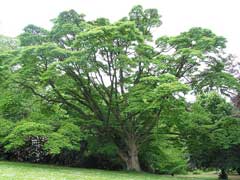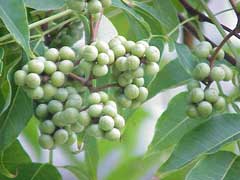 |
|
http://commons.wikimedia.org/wiki/User:Jean-Pol_GRANDMONT |
 |
| biolib.de |
Translate this page:
Summary
Bloom Color: Green, White. Main Bloom Time: Early spring, Late spring, Mid spring. Form: Rounded, Spreading or horizontal, Vase.
Physical Characteristics

 Phellodendron amurense is a deciduous Tree growing to 12 m (39ft) by 15 m (49ft) at a medium rate.
Phellodendron amurense is a deciduous Tree growing to 12 m (39ft) by 15 m (49ft) at a medium rate.
See above for USDA hardiness. It is hardy to UK zone 3. It is in flower in June, and the seeds ripen from September to October. The species is dioecious (individual flowers are either male or female, but only one sex is to be found on any one plant so both male and female plants must be grown if seed is required). . The plant is not self-fertile.
Suitable for: light (sandy), medium (loamy) and heavy (clay) soils and prefers well-drained soil. Suitable pH: mildly acid, neutral and basic (mildly alkaline) soils and can grow in very alkaline soils.
It cannot grow in the shade. It prefers moist soil.
UK Hardiness Map
US Hardiness Map
Synonyms
Plant Habitats
Woodland Garden Canopy; Secondary;
Edible Uses
Edible Parts: Fruit Oil
Edible Uses: Oil
Fruit[105, 177]. The fruit is about 1cm in diameter and has a strong scent of turpentine[200].
References More on Edible Uses
Medicinal Uses
Plants For A Future can not take any responsibility for any adverse effects from the use of plants. Always seek advice from a professional before using a plant medicinally.
Antibacterial Bitter Cholagogue Diuretic Dysentery Expectorant Hypoglycaemic Ophthalmic
Skin Stomachic Urinary Vasodilator
Amur cork tree, called Huang Bai in China, is commonly used in Chinese herbalism, where it is considered to be one of the 50 fundamental herbs, but one that should be used with care[218, 254]. A strongly bitter remedy, the bark acts strongly on the kidneys and is regarded as a detoxicant for hot damp conditions[238]. Recent research has shown that the plant is useful in the treatment of meningitis and conjunctivitis[254]. Huang Bai should only be used under professional supervision and should not be take during pregnancy[254]. The bark is alterative, antibacterial, antirheumatic, aphrodisiac, bitter stomachic, cholagogue, diuretic, expectorant, febrifuge, hypoglycaemic, ophthalmic, skin, vasodilator and tonic[4, 61, 174, 176, 178, 218, 238, 279]. It is taken internally in the treatment of acute diarrhoea, dysentery, jaundice, vaginal infections including Trichomonas, acute urinary tract infections, enteritis, boils, abscesses, night sweats and skin diseases[238, 254]. It is commonly used in conjunction with Scutellaria baicalensis and Coptis chinensis in a preparation called 'injection of three yellow herbs'[238]. It is given intramuscularly for upper respiratory tract infections[238]. The bark of 10 year old trees is harvested in the winter or spring and dried for later use[238, 254]. The fruit is expectorant[218].
References More on Medicinal Uses
The Bookshop: Edible Plant Books
Our Latest books on Perennial Plants For Food Forests and Permaculture Gardens in paperback or digital formats.

Edible Tropical Plants
Food Forest Plants for Hotter Conditions: 250+ Plants For Tropical Food Forests & Permaculture Gardens.
More

Edible Temperate Plants
Plants for Your Food Forest: 500 Plants for Temperate Food Forests & Permaculture Gardens.
More

More Books
PFAF have eight books available in paperback and digital formats. Browse the shop for more information.
Shop Now
Other Uses
Cork Dye Insecticide Oil Wood
A yellow dye is obtained from the inner bark[178]. An oil obtained from the seed has insecticidal properties similar to pyrethrum[57]. Wood - heavy, hard, strong, close grained. Used for furniture[74]. The bark is a cork substitute[74].
Special Uses
Scented Plants
References More on Other Uses
Cultivation details
Landscape Uses:Pest tolerant, Specimen, Street tree. Prefers a moisture retentive well-drained deep rich loam in full sun[11, 200]. Prefers a neutral to alkaline soil[238]. Succeeds in shallow chalky soils[245]. Grows best in areas with long hot summers[200]. Plants are gross feeders and require a rich soil if they are to perform well[11]. Dormant plants are fully hardy in Britain[188], but the young growth is liable to damage from late spring frosts[11, 188, 200]. The leaves are aromatic[188]. This species is occasionally cultivated for timber in S.E. Europe[50]. Dioecious. Male and female plants must be grown if seed is required. Special Features:Not North American native, Naturalizing, Inconspicuous flowers or blooms.
References Carbon Farming Information and Carbon Sequestration Information
Temperature Converter
Type a value in the Celsius field to convert the value to Fahrenheit:
Fahrenheit:
The PFAF Bookshop
Plants For A Future have a number of books available in paperback and digital form. Book titles include Edible Plants, Edible Perennials, Edible Trees,Edible Shrubs, Woodland Gardening, and Temperate Food Forest Plants. Our new book is Food Forest Plants For Hotter Conditions (Tropical and Sub-Tropical).
Shop Now
Plant Propagation
Seed - best sown in the autumn in a cold frame[200]. Stored seed requires 2 months cold stratification, sow in late winter in a cold frame[78, 113]. Germination is usually good. When they are large enough to handle, prick the seedlings out into individual pots and grow them on in the cold frame for their first winter. Plant them out into their permanent positions in late spring or early summer, after the last expected frosts. Cuttings of half-ripe wood, 7 - 10cm with a heel, July/August in a frame. Pot up in autumn and over winter in a cold frame. Fair to good percentage[78]. Root cuttings - obtain in December and store in leafmold in a warm place for 3 weeks. Cut into 4cm lengths and plant horizontally in pots. Grow on in a warm greenhouse. Good percentage[78].
Other Names
If available other names are mentioned here
Native Range
TEMPERATE ASIA: Russian Federation (Kurile Islands, Habarovskij kraj, Primorye, Amur, Sakhalin), China (Anhui Sheng, Beijing Shi, Hebei Sheng, Heilongjiang Sheng, Henan Sheng, Jilin Sheng, Liaoning Sheng, Nei Mongol Zizhiqu, Shandong Sheng, Shanxi Sheng), Korea, Japan (Hokkaidô, Honshu, Kyushu, Shikoku), Taiwan
Weed Potential
Right plant wrong place. We are currently updating this section.
Please note that a plant may be invasive in one area but may not in your area so it's worth checking.
Conservation Status
IUCN Red List of Threatened Plants Status :

Growth: S = slow M = medium F = fast. Soil: L = light (sandy) M = medium H = heavy (clay). pH: A = acid N = neutral B = basic (alkaline). Shade: F = full shade S = semi-shade N = no shade. Moisture: D = dry M = Moist We = wet Wa = water.
Now available:
Food Forest Plants for Mediterranean Conditions
350+ Perennial Plants For Mediterranean and Drier Food Forests and Permaculture Gardens.
[Paperback and eBook]
This is the third in Plants For A Future's series of plant guides for food forests tailored to
specific climate zones. Following volumes on temperate and tropical ecosystems, this book focuses
on species suited to Mediterranean conditions—regions with hot, dry summers and cool, wet winters,
often facing the added challenge of climate change.
Read More
Expert comment
Author
Rupr.
Botanical References
1174200
Links / References
For a list of references used on this page please go here
Readers comment
| Add a comment |
|
If you have important information about this plant that may help other users please add a comment or link below. Only comments or links that are felt to be directly relevant to a plant will be included. If you think a comment/link or information contained on this page is inaccurate or misleading we would welcome your feedback at [email protected]. If you have questions about a plant please use the Forum on this website as we do not have the resources to answer questions ourselves.
* Please note: the comments by website users are not necessarily those held by PFAF and may give misleading or inaccurate information.
To leave a comment please Register or login here All comments need to be approved so will not appear immediately.
|
Subject : Phellodendron amurense
|
|
|
|